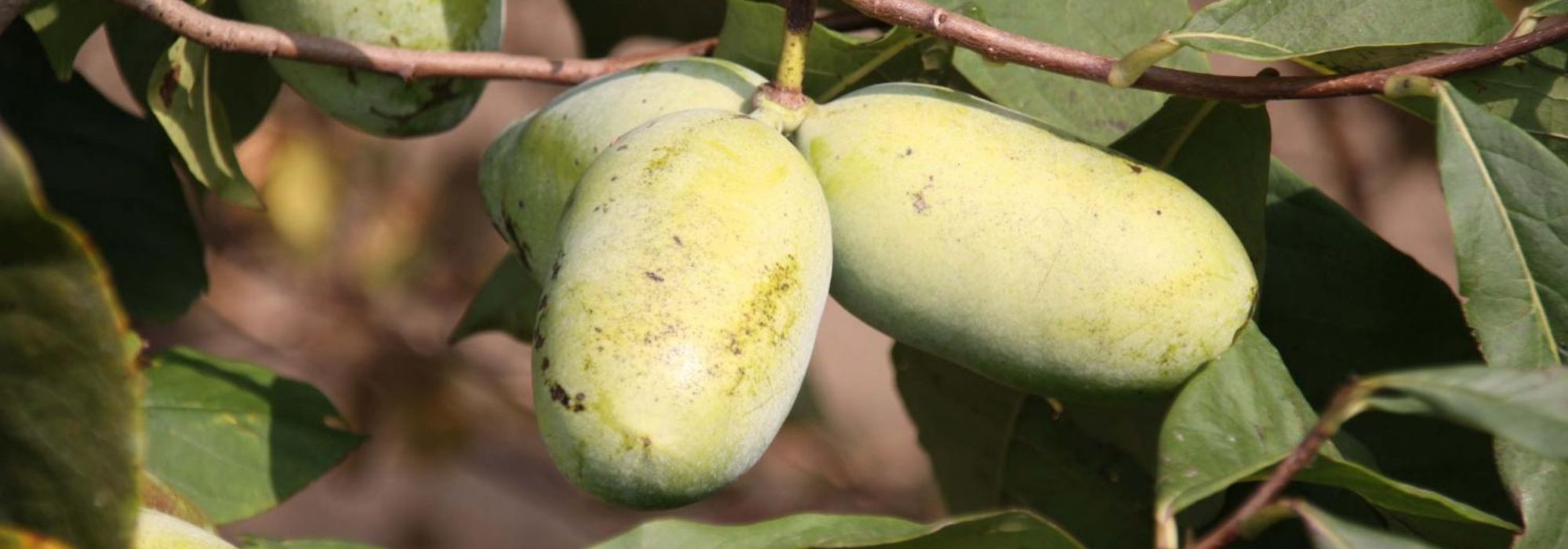
Paw paw, Asimina triloba: planting, growing, harvest
Contents
Pawpaw in a nutshell
- Asimina tree (Asimina triloba) or “paw paw” is a rather rare fruit-bearing bush with a tropical appearance
- It is prized for its large fruits, whose tasty flavour recalls mango and banana and which lend themselves to many recipes
- It offers very exotic deep burgundy-coloured flowering and foliage that turns golden in autumn before falling
- Its elegant silhouette and slow growth make it an ideal fruit tree for small gardens
- Perfectly hardy, this fruit tree native to North America is easy to grow in our gardens, in borders as well as in orchards
A word from our expert
Asimina (Asimina triloba) or trilobed asimina, nicknamed “paw paw”, remains a little-known fruit tree and is still rarely seen in our gardens. Yet this still niche fruit tree from the United States, grown for a few years in Vendée and Loire-Atlantique, is poised to conquer French gardens everywhere, as kiwi did before it.
It has everything to win you over!
Its fruits first: with a creamy, flavourful flesh reminiscent of mango and banana, they are eaten fresh or lend themselves to various recipes, from ice cream to smoothies, and also compotes, juices or jams! Then, its exemplary hardiness (-25°C) makes it a fruit tree capable of facing our winters without flinching.
Its very exotic chocolate-purple flowering and foliage that turns golden in autumn deserve a place in the garden or in a new orchard with a taste for travel!
Low-maintenance once well established in fresh, slightly acidic, well-drained soil, simply water it when dry and prune it if necessary.
Description and botany
Botanical data
- Latin name Asimina triloba
- Family Annonaceae
- Common name Asimina, Paw-paw, Indiana banana
- Flowering March to May
- Height 5 to 10 m
- Sun exposure Sun, partial shade
- Soil type Neutral, acidic, well-drained and fresh
- Hardiness -25°C
Native to forests and sandy riverbanks of United States and Canada, Asimina triloba (Asimina triloba) — also called “paw-paw” is a fruit tree belonging to family Annonaceae.
Very rare in cultivation, it is almost unknown in our European gardens. Though considered exotic because of its rarity, Asimina triloba has nevertheless adapted well to temperate climates, showing very good hardiness down to -25°C.
Genus comprises 6 species of bush and one small tree species, Asimina triloba, which has given rise to a number of self-fertile varieties such as ‘Sunflower’ or ‘Prima 1216’.
Slow to establish, especially during first years, Asimina develops from a long taproot into a small tree with a straight trunk, rarely exceeding 5 to 10 m in height, about 3 to 5 m in width at maturity. In our gardens it is generally limited to 5 or 6 m. It displays an upright pyramidal habit but can be trained as a goblet to simplify harvest. Bark, which cracks with age, contains alkaloid substances widely used in medicine. Of a pretty dark brown to greyish colour, wood of Asimina is also considered a semi-precious wood.
In March–April, before leaf emergence, flowering appears, borne on thin, villous twigs, marked with fine striations. Visible in the axil of leaves from summer of previous year, floral buds need winter cold to develop properly and are then ready to open. Round, slightly villous buds set in a villous green-yellow calyx flushed with purple open into small pendulous bells 4 to 5 cm in diameter, solitary or grouped in small clusters. They are formed of 6 petals imbricate in threes, forming two corollas. Their rounded, symmetrical shape evokes camellia flowers. Petals, strongly veined with a puckered appearance, show a pretty red-chocolate colour tending to claret and surround a crown of numerous yellow stamens.

Asimina triloba – botanical illustration
This nectariferous flowering lasts about 6 weeks. Flowers exhale a very unpleasant smell of carrion (perceptible only up close) that attracts certain insect pollinators such as flies (common flies, dung flies), butterflies and beetles.
This delicate, exotic-looking flowering precedes fruiting. Fruiting occurs only after 3 to 6 years of cultivation. Most new Asimina triloba varieties are self-fertile: a single tree is enough to produce fruit, though some varieties require presence of several asimina trees to fruit.
Fruits called asimines are large, elongated oval berries, grouped by 3 or 6 like a bunch of bananas, hence another nickname “Indiana banana”. Measuring 8 to 18 cm, they resemble young green mangoes but a little more swollen and can weigh up to 400 grams. Their smooth, tender skin is green-yellow or yellow at ripeness. Their pulp, generally yellow, sometimes orange, contains large black inedible seeds arranged in two rows, making them resemble papaya flesh.
Creamy pulp has a tangy, sweet flavour reminiscent of mango, pineapple and banana. Fruits are harvested ripe between late August and mid-October and are eaten fresh or used for juice, milkshakes, compote, ice cream, sorbet and even in some beers!
Deciduous foliage of this little-known fruit tree is also noteworthy. Asimina produces leaves rather late in spring, generally in May after flowering, and displays a magnificent foliage until autumn. Leaves 15 to 30 cm long with a short petiole are alternate, simple, obovate and pendulous like small umbrellas. Deeply veined and ending in a point, they have a crinkled appearance not unlike chestnut leaves.
Bright green at bud burst period and in summer, leaves turn a pretty golden-yellow at first autumn chills before falling.

Asimina : flowers, immature fruits and a ripe fruit with delightfully creamy, tangy and sweet pulp
Although Asimina does not fear severe cold (hardy down to -25 °C), it actually benefits from a fairly harsh winter which promotes flowering. It dislikes too-hot climates and soils that are too dry in summer. To flower well, it prefers full sun north of Loire and partial shade if summers are very hot. It tolerates any good garden soil provided it is deep, consistently fresh and well-drained, with neutral or slightly acidic pH.
It can be grown either solitary at back of a border with ericaceous plants or, of course, in groups in an orchard. In autumn it provides a lovely contrast alongside bushes with decorative foliage.
Asimine pulp is rich in vitamins A and C as well as amino acids and trace elements, while Asimina leaves contain an insecticidal substance and its bark has interesting medicinal properties under study in research into cancer treatments.
Main species and varieties
Although there are fewer than ten Asimina species, only Asimina triloba, or “Paw Paw”, has been subject to selections and research, carried out exclusively in the United States. It has given rise to several interesting self-fertile cultivars.
Most popular
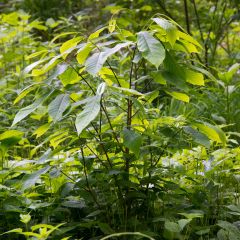
Asimina triloba - Pawpaw
- Flowering time April to June
- Height at maturity 10 m
Our favourites
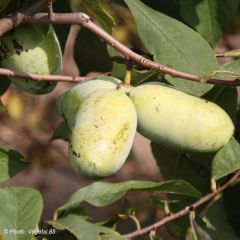
Asimina Sunflower - Pawpaw
- Flowering time April to June
- Height at maturity 10 m
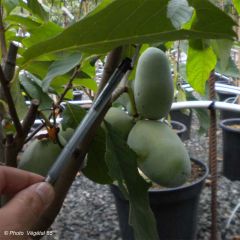
Asimina Prima 1216 - Pawpaw
- Flowering time April to June
- Height at maturity 10 m
Discover other Asimina trees
View all →Available in 2 sizes

Available in 2 sizes

Available in 3 sizes
Available in 1 sizes
Available in 1 sizes
Available in 1 sizes
Available in 1 sizes
Available in 1 sizes
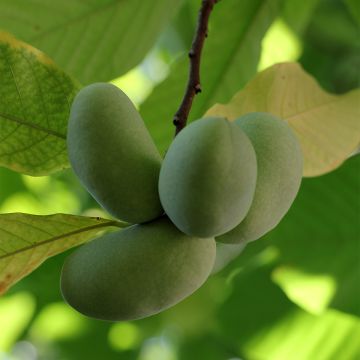
Available in 1 sizes
Available in 1 sizes
Pawpaw planting
Where to plant Asimina triloba?
Perfectly hardy, Asimina is capable of withstanding temperatures down to -25 °C, which gives it good resistance in most regions. It is best avoided in Mediterranean climate, however, as summers are too hot and dry.
Give it a spot sheltered from cold winds and spring frosts that can burn foliage and damage flowers.
To promote good flowering, plant in full sun, or in partial shade if sun is not too scorching, in any good moderately fertile garden soil, neutral or preferably acidic, deep, and remaining consistently moist and well-drained.
Choose location carefully because once well rooted, the delicate taproot of Asiminia triloba does not like being moved. As its pollination is mainly by flies and beetles, presence of manure or compost nearby is therefore recommended.
It can be planted at the back of a border with ericaceous plants and naturally finds its place in an orchard.

Asimina takes on beautiful golden autumn colours
When to plant Asimina?
To encourage rooting, plant Asimina preferably in February–March before growth starts, or in autumn, from September to November.
How to plant Asimina?
Although new cultivars are often self-fertile, plant at least two Asimina trees close together for a better fruit set: allow a spacing of 2.5 to 3 m between two Asiminia triloba. Container growing can be attempted, but is not recommended because this fruit tree needs deep soil to develop and its taproot may feel too confined.
Planting:
- Loosen soil well to 80 cm in all directions
- Dig a hole 3 to 5 times wider than the rootball
- Place a layer of gravel at the bottom of the planting hole
- Plant Asiminia at collar level, avoiding handling fragile roots, in a mix of garden soil, heather soil and an addition of compost or manure
- Backfill the hole
- Firm lightly
- Water generously then regularly during first year after planting
Maintenance, pruning, care and harvest
Once well established, Asimina is, unlike many fruit trees, one of the easiest trees to maintain. It does not tolerate dry soils well and prefers soils that retain some moisture: it needs regular watering, especially during first three years because soil must remain cool throughout summer. After two or three years it will better withstand a short drought. Mulch the base every spring.
Over time, Asimina tends to produce suckers: remove suckers regularly but above all do not hoe at its base, because its roots are fragile.
This fruit tree is not very susceptible to disease and parasitic organisms, a resistance due to insecticidal substances released by its leaves and its bark that naturally repel pests.
Pruning Asimina
Pruning Asimina is simple and should not be drastic. It consists of keeping the tree at a reasonable height of 2.50 to 3.50 m to make fruit harvesting easier. Carry out in winter, from January to February:
- With a pruning shear, remove inward-growing branches to open up the branches
- Cut branch ends on a slant
A goblet-shaped pruning makes fruit picking easier: with a pruning shear cut the leading shoot and over successive winters distribute 5 to 6 main branches evenly around the trunk.
→ to read on the subject: “How to form a fruit tree into a goblet?”
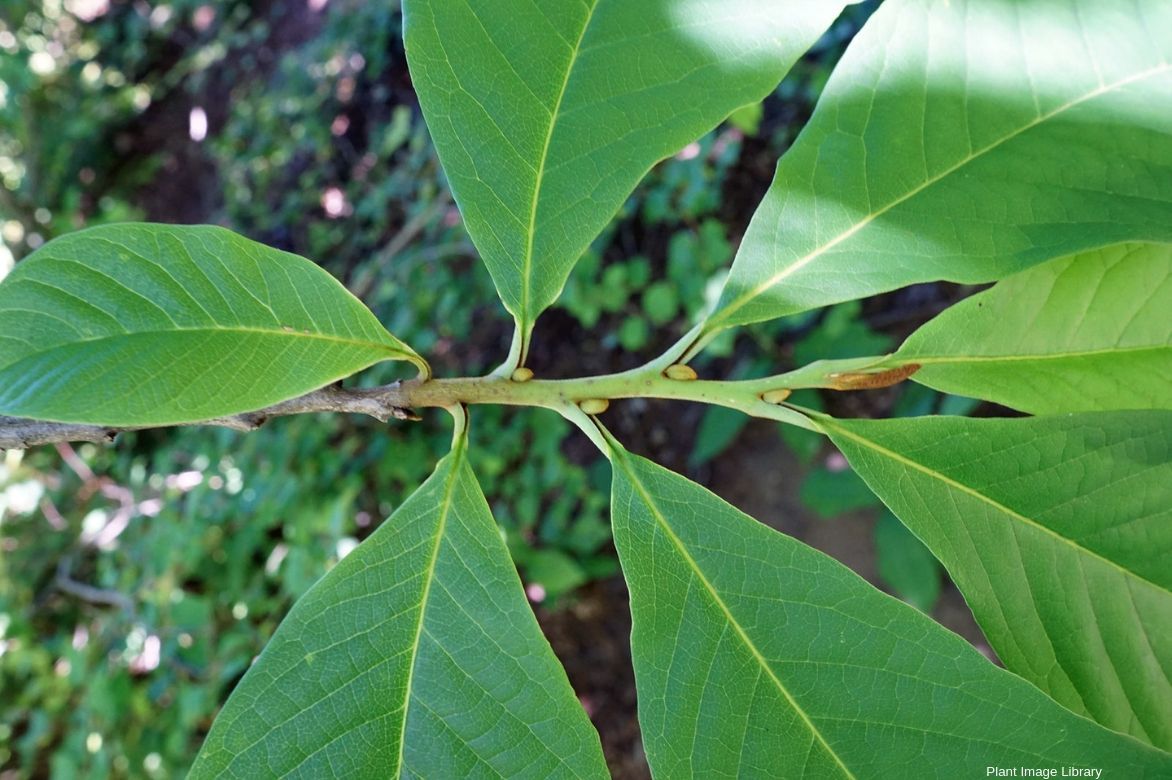
Pawpaw shoot
Harvesting the fruit
Harvesting Asimina fruit takes place from late summer to mid-October depending on region, once fruits are soft to the touch, detach easily from the tree and before they become too brown. Seeds are relatively toxic and should not be eaten.
Multiplication
Pawpaw propagation is carried out either:
- by sowing, a method that requires patience as seeds need a long period of stratification, root development is very slow and the appearance of roots can take several years,
- by grafting, using a rather specialised technique that requires some technical expertise.
You can also remove the suckers that develop around the mother plant, but you will have to wait up to 8 years to see them flower.
We recommend buying young plants instead.
Associate
Asimina triloba offers two seasons of ornamental interest: in spring, when it is covered with its purple flowers and bright green foliage, and in autumn when its leaves turn golden yellow and its ripe fruit give it a tropical appearance. It will thrive in any exotic garden!
In spring, surround its base with spring bulbs such as muscari, scillas and botanical tulips, in mauve–purple harmonies. Groundcover perennials like bergenias, creeping bugles and heucheras will take over after flowering and keep its roots cool all summer.

An autumn planting idea: Asimina triloba, with in front of it in sun a sea of Rudbeckia subtomentosa ‘Little Henry’ and Miscanthus sinensis ‘Little Miss’. If you want a little contrast, add a Cotinus with purple foliage.
Asimina triloba can also find a place in a heather soil border, alongside flowering bushes or bushes with evergreen foliage such as Camellias, Chinese and Japanese Azaleas, Rhododendrons, Japanese Andromedas, Cornus.
In autumn, its leaves’ golden blaze will complement Cotoneasters or other ornamental fruit trees such as Amelanchiers, Callicarpa, and the beautiful leaf colours of Cotinus, acers, a caramel tree, a scarlet oak, Japanese dogwoods or even a Euonymus.
Useful resources
- Discover our buying guide to choose an Asimina tree.
- Discover our unique collection of Asimina trees and all our original and exotic fruit trees!
- Discover diseases and parasitic pests affecting Asimina trees
- Our tutorial: How to harvest and store Asimina fruit?
- All tips to grow, protect and maintain your fruit trees are on our blog
- Find out more with Pascale on the blog: Growing superfruits is possible
- Subscribe!
- Contents
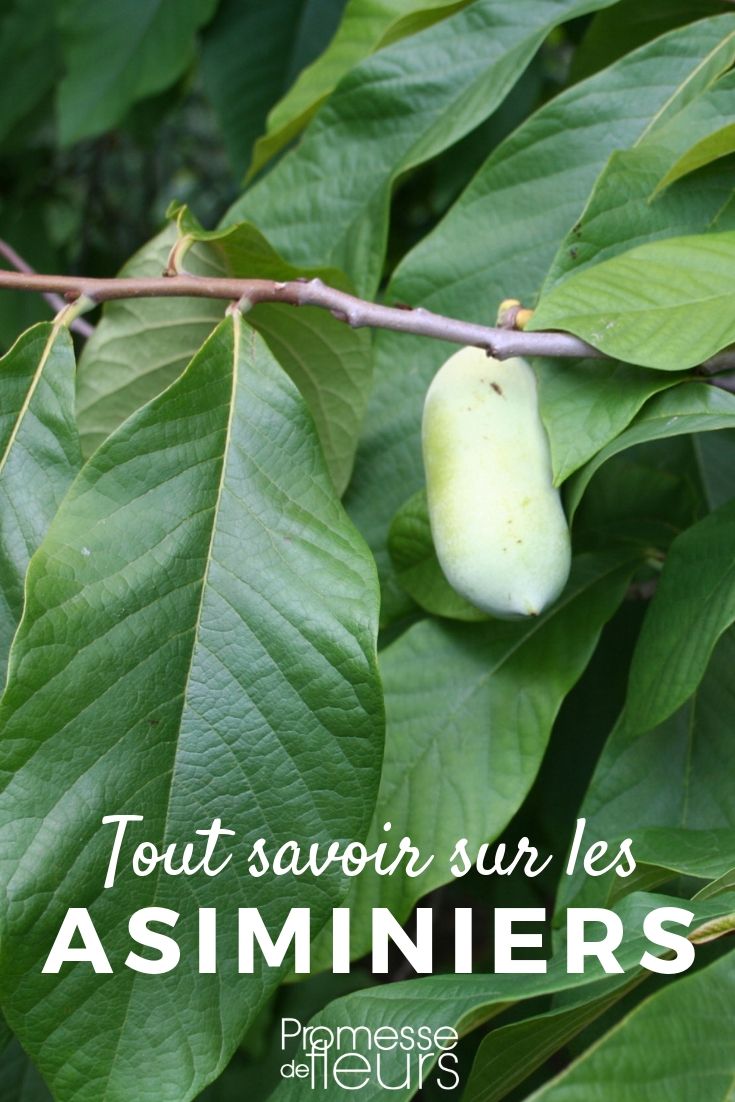































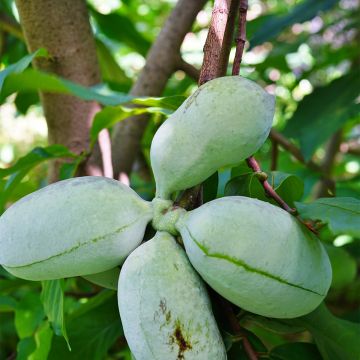
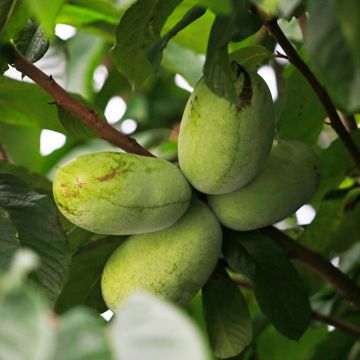
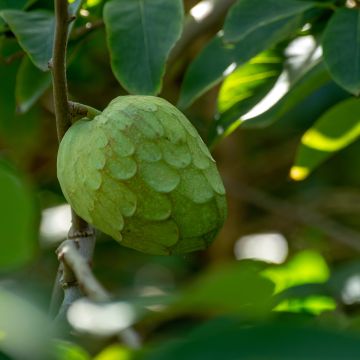
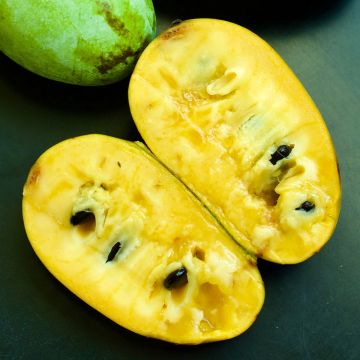
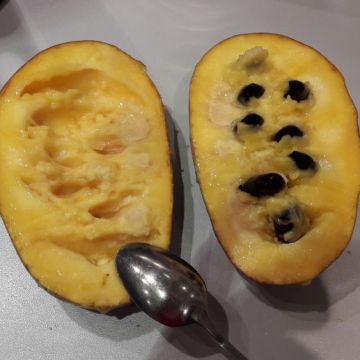
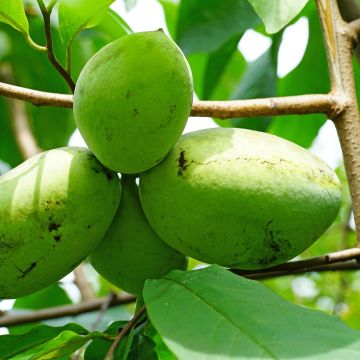
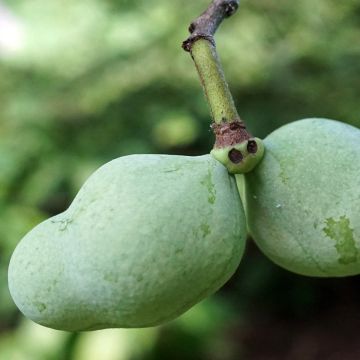
Comments